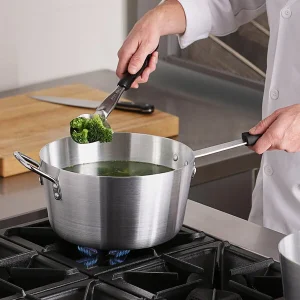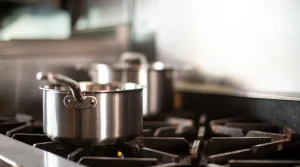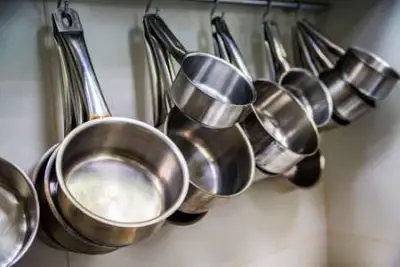Saucepan sizes are an often underestimated yet crucial aspect of any well-equipped kitchen. Whether you’re a seasoned home chef or just beginning your culinary journey, the importance of selecting the right saucepan size cannot be overstated.
These versatile kitchen tools come in various dimensions, each catering to specific cooking needs and occasions. In this article of saucepan sizes, we’ll delve into the world of these essential cooking vessels, uncovering the secrets behind their varied dimensions and helping you make informed choices for your culinary adventures.
What are common saucepan sizes?

Common saucepan sizes can vary, but they typically come in a range of sizes to accommodate different cooking needs. The most common saucepan sizes are:
- 1-Quart (0.95 liters) Saucepan: This is the smallest size and is ideal for heating small amounts of liquids, making sauces, or reheating leftovers.
- 2-Quart (1.9 liters) Saucepan: Slightly larger than the 1-quart size, this saucepan is great for cooking grains, steaming vegetables, and making sauces.
- 3-Quart (2.8 liters) Saucepan: A versatile size for everyday cooking tasks, including boiling pasta, making soups, and simmering sauces.
- 4-Quart (3.8 liters) Saucepan: A bit larger, this size is suitable for preparing larger batches of soups, stews, and sauces.
- 6-Quart (5.7 liters) Saucepan: This larger saucepan is excellent for cooking pasta, blanching vegetables, and making large quantities of sauce or soup.
- 8-Quart (7.6 liters) Saucepan: Considered a stockpot by some, this size is ideal for making stocks, big batches of soup, or boiling large items like corn on the cob or lobster.
Keep in mind that the specific sizes may vary by brand and manufacturer, but these are the most common sizes you’ll encounter when shopping for saucepans. Choosing the right size saucepan depends on your cooking needs and the number of people you typically cook for. Having a variety of saucepan sizes in your kitchen can be helpful for different cooking tasks.
How do saucepan sizes vary?
Saucepan sizes can vary primarily in terms of their capacity, which is usually measured in quarts or liters. The main variations in saucepan sizes are:
- Capacity: The primary difference among saucepan sizes is the amount of liquid or food they can hold. Smaller saucepans typically have capacities ranging from 1 to 2 quarts (approximately 0.95 to 1.9 liters), while larger ones can range from 3 to 8 quarts (approximately 2.8 to 7.6 liters) or even more. The capacity determines how much you can cook or heat in the saucepan.
- Diameter and Depth: Saucepans with the same capacity can vary in their dimensions. Some may have wider bottoms and shallower sides, while others may have narrower bottoms and taller sides. The choice of dimensions can affect the cooking process, such as how quickly a liquid evaporates or how evenly heat is distributed.
- Materials: Saucepans can also vary in the materials they are made from. Common materials include stainless steel, aluminum, copper, and nonstick coatings. Different materials conduct and distribute heat differently, which can affect cooking performance.
- Handle and Lid: The design of the handle and lid can vary from one saucepan to another. Some saucepans have long, ergonomic handles for easy gripping, while others may have shorter handles or even two handles for better balance and maneuverability. Lids can be made of glass or metal and may have different types of handles or knobs.
- Weight: Larger saucepans with thicker materials may be heavier, which can impact ease of handling and storage.
When selecting a saucepan, consider your cooking needs and preferences. A variety of saucepan sizes can be useful in the kitchen, as they allow you to choose the right one for a specific task. Smaller saucepans are suitable for heating sauces and small quantities of food, while larger ones are better for boiling pasta, making soups, or cooking for a crowd.
Additionally, the material of the saucepan and its design features can also influence your choice based on factors like heat conductivity, ease of cleaning, and durability.
What size saucepan is best for single servings?
The best size saucepan for single servings will typically be in the range of 1 to 2 quarts (approximately 0.95 to 1.9 liters). Here are some considerations based on the type of food you’ll be preparing:
- 1-Quart (0.95 liters) Saucepan: This size is perfect for single servings of sauces, gravies, or heating up small portions of leftovers. It’s also suitable for warming milk, making oatmeal, or poaching an egg.
- 5-Quart (1.4 liters) Saucepan: This size is a versatile choice for single servings. It’s great for cooking small batches of pasta, steaming vegetables, making rice, or heating up soups and stews.
- 2-Quart (1.9 liters) Saucepan: A 2-quart saucepan is slightly larger and provides more versatility. It’s ideal for cooking grains like rice or quinoa, making sauces, reheating larger portions of soup, or cooking small servings of pasta.
The specific size you choose depends on the type of meals you typically prepare and your personal cooking preferences. If you often cook single servings of various foods, having a range of saucepan sizes in the 1 to 2-quart range can be beneficial. This way, you can choose the size that best suits the task at hand while minimizing food waste and energy consumption.
Which saucepan size is ideal for soups?

The ideal saucepan size for making soups can vary depending on the quantity of soup you want to prepare. Here are some general guidelines:
- 2-Quart (1.9 liters) Saucepan: A 2-quart saucepan is suitable for making smaller batches of soup, typically enough for 2 to 4 servings. It’s a good choice for quick, single-pot soups or when you don’t need to make a large quantity.
- 3-Quart (2.8 liters) Saucepan: This size is versatile and can accommodate a wider range of soup recipes. It’s ideal for making medium-sized batches of soup, usually serving 4 to 6 people. It provides enough room for simmering ingredients and stirring comfortably.
- 4-Quart (3.8 liters) Saucepan: If you often make larger batches of soup or enjoy having leftovers, a 4-quart saucepan is a good choice. It can typically serve 6 to 8 people and provides ample space for simmering and combining ingredients.
- 6-Quart (5.7 liters) Saucepan: While this size is often considered a stockpot, it can also be used for making substantial batches of soup. It’s great for cooking large quantities of soup for gatherings, parties, or freezing for future use.
The choice of saucepan size for soups ultimately depends on your cooking habits and the number of people you typically serve. If you enjoy making a variety of soups, having multiple saucepan sizes on hand can be helpful to accommodate different recipes and serving sizes.
Additionally, consider the depth of the saucepan, as a deeper saucepan can help prevent soup from boiling over while simmering.
What size saucepan for reheating leftovers?
The best size saucepan for reheating leftovers depends on the amount of leftovers you have. A small saucepan, with a capacity of 1 quart or less, is ideal for reheating smaller portions of leftovers.
A medium saucepan, with a capacity of 1.5 to 2 quarts, is a good size for reheating larger portions of leftovers. A large saucepan, with a capacity of 3 quarts or more, is not necessary for reheating leftovers, unless you are reheating a very large amount of food.
Here are some general guidelines for choosing the right size saucepan for reheating leftovers:
- For reheating a single serving of leftovers, use a small saucepan.
- For reheating 2-3 servings of leftovers, use a medium saucepan.
- For reheating 4-6 servings of leftovers, use a large saucepan.
It is also important to choose a saucepan that is made of a material that is safe for reheating food. Stainless steel, cast iron, and enamel-coated pans are all good choices. Avoid using aluminum pans, as they can react with acidic foods and give them a metallic taste.
Which saucepan size suits pasta cooking?
A 3-quart or 4-quart saucepan is the ideal size for cooking pasta. This size will allow the pasta to cook evenly and prevent it from sticking together. It is also large enough to accommodate a generous amount of pasta, so you can cook for a crowd.
Here are some tips for choosing the right saucepan size for cooking pasta:
- Consider the amount of pasta you will be cooking. A 3-quart saucepan can hold about 1 pound of pasta, while a 4-quart saucepan can hold about 1.5 pounds of pasta.
- Make sure the saucepan is deep enough to allow the pasta to cook in plenty of water. The water should cover the pasta by at least 2 inches.
- Choose a saucepan with a heavy bottom. This will help to prevent the pasta from sticking to the bottom of the pan.
How do saucepan sizes affect cooking times?
The size of a saucepan affects cooking times in a few ways:
- The larger the saucepan, the more surface area it has. This means that more heat can be transferred to the food, which can speed up cooking times. However, it also means that the food will be more spread out, which can make it cook unevenly.
- The smaller the saucepan, the less liquid it can hold. This means that the food will have to cook in a more concentrated liquid, which can also speed up cooking times. However, it also means that the food will be more likely to stick to the bottom of the pan.
- The depth of the saucepan also matters. A deeper saucepan will allow the food to cook more evenly, as the heat will be distributed more evenly throughout the pan. However, a shallow saucepan will cook the food faster, as the heat will be concentrated more in the bottom of the pan.
Ultimately, the best saucepan size for a particular dish will depend on the specific ingredients and cooking method. However, as a general rule of thumb, it is best to use a saucepan that is large enough to accommodate the food without crowding it, but not so large that the food will cook unevenly.
How to choose the right saucepan size?

The right saucepan size depends on a few factors, including:
- The number of people you cook for.
- The types of dishes you typically cook.
- The amount of storage space you have.
Here are some general guidelines for choosing the right saucepan size:
- For one or two people, a 1- or 2-quart saucepan is a good size.
- For a family of four, a 3- or 4-quart saucepan is more appropriate.
- If you cook large batches of food or soups, you may need a larger saucepan, such as a 6- or 8-quart size.
If you frequently cook different types of dishes, it’s a good idea to have a variety of saucepan sizes. For example, you might want a small saucepan for making sauces and a larger saucepan for boiling pasta.
It’s also important to consider the amount of storage space you have. If you have limited space, you may want to choose smaller saucepans that can be stacked.
Conclusion
Saucepan sizes are an essential consideration in any kitchen. The right size can make a significant difference in cooking efficiency and versatility. Whether you need a small saucepan for delicate sauces or a larger one for soups and stews, choosing the appropriate size will enhance your cooking experience and help you achieve delicious results.
So, when it comes to saucepans, remember that size truly matters in the world of culinary convenience and creativity.


